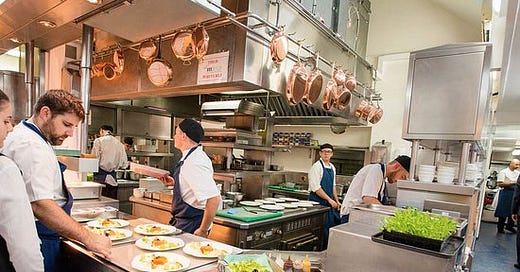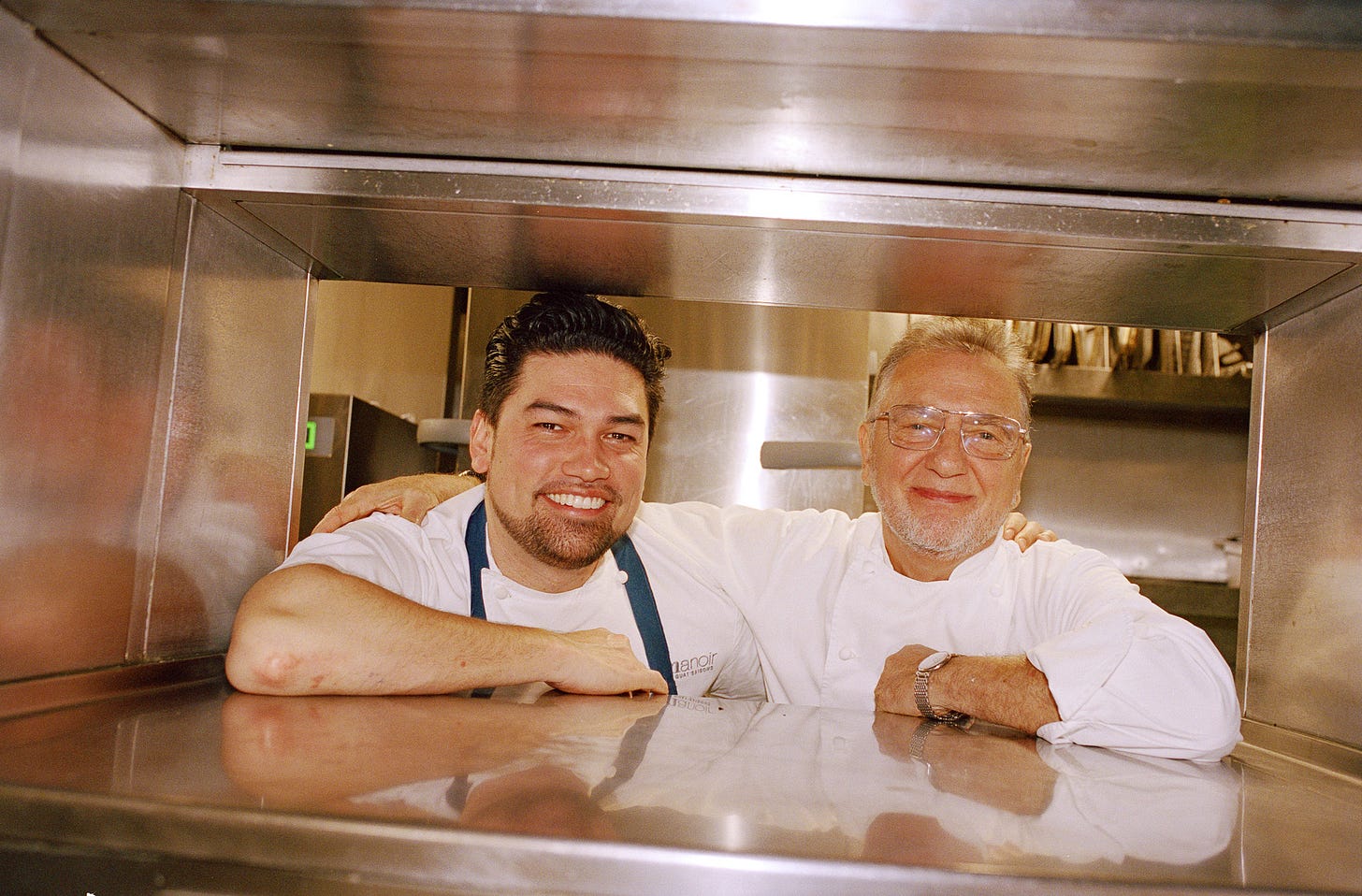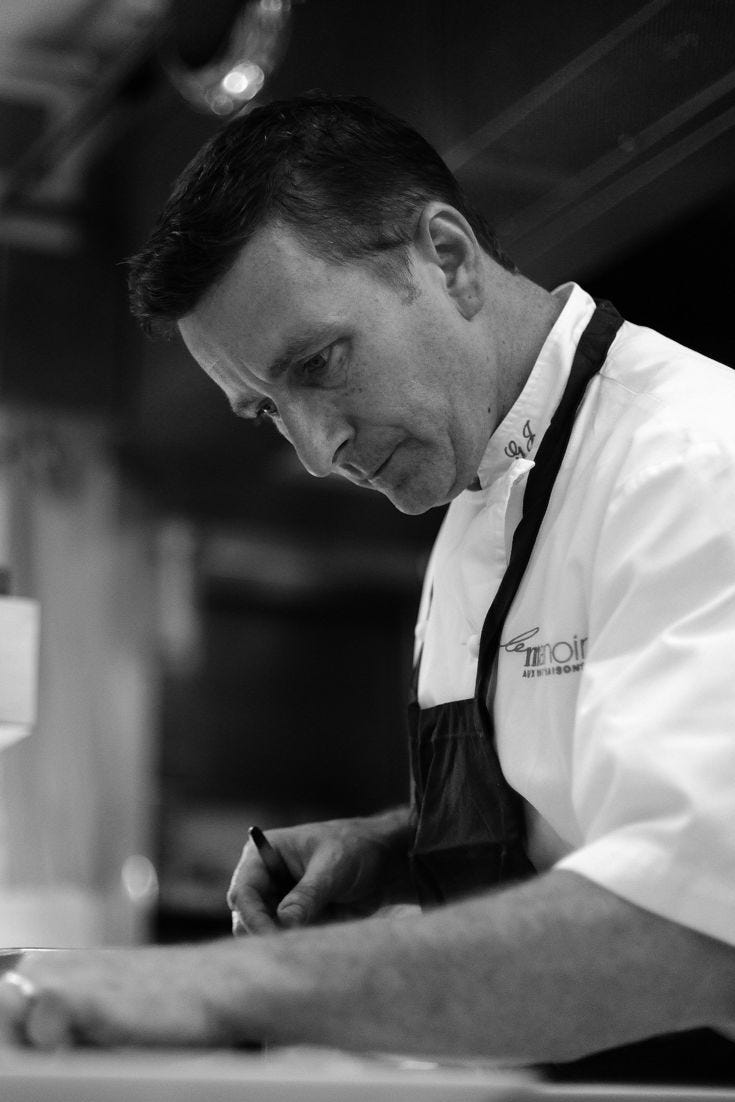Fraser’s kitchen nightmares
Having siblings is important because you learn how much you can annoy someone before they snap and try to kill you. In many ways, working in a professional kitchen is kinda the same.
With Eat My Words on a summer break, and after the roaring success of last month’s email detailing my time with Raymond Blanc, this week we’re doing part two of my memoir.
How many parts this memoir has is a mystery to both you and us, but this part is all about what happens when the orders start coming through. How do you know when to start cooking a dish? What happens when someone fucks up? And what do OFT, NFW and PYS mean?
Grab a coffee and a choccy bourbon, this is a long read but a strong read…
A table has just ordered their food.
What happens next?
Of the two senior chefs at the pass - where dishes are placed for servers to take out - the more experienced one will run the side doing appetisers (apps), and cold and hot starters because there’s more going on there. They’ll receive the check (the order), which at the time was handwritten but will now be automated, and say: “Check on. Two covers…”
Then, depending on what the two diners had ordered, we’d hear something like: “One a la carte, no dairy. One tasting, fish starter.”
The chef then wrote this info on a big board which the whole kitchen sees. You see the table number, number of covers, what menu and choices they want, and any notes. Crucially, a time will be put up for when the apps need to go out. If a check comes on at 7.28pm then the apps need to go in 5 minutes. Because it got confusing having odd numbers, you round up to the nearest 5 or 10 i.e. the apps would go at 7.35pm.
And when I say 7.35pm, I mean to the second. You can’t present stuff early or late.
If you’re running a section then you’d call out ‘eyes on’ when you’re happy with the dish and the senior chefs would come and have a look before the dish went out. They’d then mark on the board that that’s been sent and put a new time on for when the cold starter needs to go.
Enter Fraser…
When I started at Le Manoir I was on cold starters where we had a confit salmon dish.
When the time went on the board I would get the plate laid out and start to build up the garnishes. I’d drain off the veg if they were pickled, then 2 mins before the go-time I’d get the salmon out of its Radox bath (it was served at 40 degrees so it was warm but not hot) and transfer it to the plate. With 30 seconds to go, I’d put everything else on that ‘perishes’ quickly i.e. caviar, micro herbs or yuzu crème fraîche.
When I moved up to fish and meat, you’d need to really plan ahead. If you had a lamb dish on the lunch menu then you’d colour a decent number before service, say 70 odd, and then finish them off when the time came. You only did that for stuff you knew you were going to need i.e. you’d never colour off pigeon as that’s less popular. When a check did call for pigeon, you’d get it out of the fridge and start colouring it while working on everything else.
Timings between courses
There are normally 10 minutes between apps going out and cold starters going out, 15 minutes between cold and hot starters, 20 minutes between hot and fish, and 20-25 between fish and meat. Le Manoir has worked out the exact timings based on when the food goes out, not when it’s cleared from the table.
99% of the time the diners are eating at the exact timings we’ve worked out. You’re constantly pre-empting things but at least you’re working to your timings, not the table’s. This is different from most restaurants.
In most, normally the waiting staff would come into the kitchen when the table is clear, say they are ready for their next course, and you’d begin cooking. In principle this is fine, but in practice the waiting staff might be slow to clear the table and so the diners start to get antsy.
What happens if people are eating slowly?
The waiter would come in and tell us to change the pace. Sometimes they would tell us too late and half the dish would be at the pass. At this point, someone usually gets upset.
The head chef will ask if another table is ahead of time to see whether the half-ready dish can go somewhere else. If it can’t - and this didn’t happen that often - the dish goes in the bin.
What happens if you fall behind on timings?
If you see you’re not going to make the time on the board then you can start to group tables together. If you’ve got four tables, two with starters going at 7.35pm and two going at 7.40pm, then you ask the chef to group them for 7.40pm. This saves a bit of time as you set up plates in one batch.
It might make it easier for you, but you’re then forcing the next section along to group everything together too. If you start getting behind, then you’re going to be behind for everyone.
If a table is regularly getting food after the times on the board, the senior chef would put OFT (‘on fucking time’) or NFW (‘no fucking wait’) by their next time. If that sign went up you had to do whatever you could to make sure nothing went wrong.
As a diner, you shouldn’t notice any of this drama. When I went with my Mum a few years ago it felt flawless, but when I went into the kitchen afterwards they had NFW next to our table. We weren’t sitting there thinking there was a long wait-time and that’s in part to the waiters who should distract you with extra bread, more wine etc. etc.
Who cooks the food?
Who dresses the plate?
On each section, one person should cook and one should plate. If it’s really busy, some people will just plate up a dish all night. If you’re a bit junior, that’s how you start: you spend 3-4 months not cooking, but simply learning and dressing the plate.
In order to move up a section, you have to have trained your junior properly so that they can fill your position. If they’re not ready then you don’t move up.
This is what makes Le Manoir so different and, in many ways, so special. It’s all about training. You have to have trained someone so that if you disappeared for the day, the junior member would be able to do everything without a glitch. You’re trained to cook, and to train and manage people.
If a junior on a section messes up then the more senior one gets the bollocking. It’s then the senior’s decision whether they pass that bollocking onto the junior.
Example: when I was on cold starters I had a mackerel dish which was finished under the grill. I was at a point where I was supposed to be letting the guy I trained step up, but he kept leaving the mackerel under the grill too long.
Mackerel at Le Manoir is treated with a lot of care. You’re only allowed to use that morning’s catch (never yesterday’s as it decomposes so quickly) and it would only ever be on the lunch menu as by dinner it wasn’t good enough. As a result, the restaurant was strict about how much they bought. When you ran out, you ran out.
Problem: my junior got to a point where he’d burnt so many portions that we didn’t have enough for the last table. Not good. Enter Gary Jones (see last month’s email for reminder on him) who re-portioned everything (stretching the remaining mackerel across the final plates) and raked me over the coals. In his words: “If you’re not in control of him then you’re not in control of your section.”
But you’re never just worrying about your section…
Luke Selby (pic below, Le Manoir’s current Executive Chef who left to run Evelyn’s Table but returned last year) gave me a lot of tips on how to run a section properly, like making your junior go to the fridge to pick things up (it was a 20-metre journey) so you never missed a check-call and could scan the other sections.
This is another thing that makes Le Manoir so unique: it doesn’t matter how well you’re doing, if the section before you is screwing up then it will affect you. This becomes more relevant the senior you get as you’ve got more sections before you which might mess up. It becomes really important to not just look at your own thing.
Example: the fish course goes out before the meat. If the fish guy’s fucked up and the meat guy has to do something again, the senior chef at the pass needs to come up with a solution. But if that senior chef wants to make a thing of it, they might have a go at the meat guy as it’s that guy’s responsibility to communicate with everyone.
If the fish guy needed 30 seconds more, you in meat should have realised. Even if you’re cooking everything well and doing your job properly, you are accountable for other people. You should constantly be checking up to see if everything’s going ok.
PYS
At first, getting everything ready for a certain time and making sure it’s the best thing you’ve ever cooked is no joke. But after a while you realise how structured everything is. You get your prep work checked off, you have your set times, and it’s in everyone’s interest to support you.
That said, if you went to a senior chef and said you were worried about having too much to do, they might simply reply: “push yourself” or “PYS”. This was an internal language for ‘you’re being tested, you’re not alone and everyone is aware of what’s going on, but do better.’
Sometimes, Gary Jones would write a massive PYS on the board if things had gone badly with that service. If that happened at lunch you knew things would have to go well at dinner.
This isn’t a Steve Bartlett podcast on what the corporate world can learn from kitchens, but having that codified shorthand replaces long and difficult conversations. It gives you the ability to quickly get more from the people around you without having to tip-toe around the issue.
Final thought
Part II done. Hopefully it’s like the Godfather sequel rather than the Legally Blonde sequel.
Normal EMW service will resume at the end of this month. In the meantime, eat ice cream.
Speak soon,
Fraser









